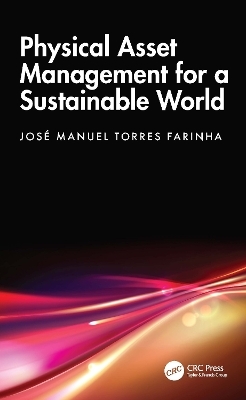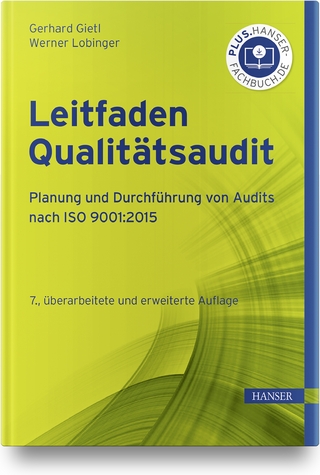
Physical Asset Management for a Sustainable World
CRC Press (Verlag)
978-1-032-42835-2 (ISBN)
This book describes techniques, tools, and models about engineering maintenance and life cycle models, aimed at the efficient managing of assets. It presents new asset management models, namely the Holistic Diagnostic Model (HDM) and Integrated Asset Management Support Model (IAMSM), including quantitative decision support tools for life cycle management of physical assets. It presents an overview of the life cycle models for replacement through a global model, with emphasis on availability and maintenance costs.
Features:
Covers important aspects on Physical Asset Management (PAM) and offers a developed perspective on the economic aspects.
Presents the relationships among some maintenance Key Performance Indicators (KPI), specifically MTTR, MTBF, Availability, and Reserve equipment.
Analyzes models to calculate the influence of relevant variables on the withdrawal time and in the reserve size of the critical assets.
Introduces new diagnostic models and Life Cycle decision support models.
Includes new models for diagnosing organizations including pertinent case studies.
This book is aimed at researchers, professionals, and graduate students in PAM, maintenance management, and industrial engineering.
José Manuel Torres Farinha has Habilitation in Electrical and Computer Engineering, a PhD in Mechanical Engineering and a degree in Electrical Engineering, option Energy. He is a National Defence Auditor. He is Full Professor in Coimbra Polytechnic Institute (IPC) and its former President. He is the Coordinator of the Master's Degree in Engineering and Management of Physical Assets in IPC. He has completed several PhD supervisions and dozens of Master's degree orientations. He has published three books, two in National edition and one in International edition. He has more than 250 publications – articles in indexed and non-indexed international journals, in national magazines and in proceedings of international and national congresses. He has several registered patents (National and International). He is Specialist Member of Industrial Maintenance Specialization and a Counsellor Member of the Portuguese Association of Engineers.
PART I Life Cycle Models. 1 Life Cycle Cost of Physical Assets. 1.1 Introduction. 1.2 Life Cycle Models. 1.3 Economic Life Cycle. 1.4 Performance Indicators. 1.5 Investment Analysis Methods. 1.6 New Economic Replacement Models. 1.7 Reserve Set. 1.8 Life Cycle Considering Incomes. 1.9 Simulation of Methods Application. References. 2 Life Cycle Investment of Physical Assets. 2.1 Introduction. 2.2 The Model of a Holistic Approach of the Physical Assets Life Cycle. 2.3 LCI Considering Maintenance and Non‑Production. 2.4 Case Study Simulation. 2.5 Conclusions. References. 3 Life Cycle of Physical Assets with Recovery. 3.1 Introduction. 3.2 Methodology. 3.3 Basic Concepts to Support Math Models. 3.4 Behaviour of the Physical Asset Value along Time. 3.5 Production Economic Movements. 3.6 Functioning Economic Movements. 3.7 Global Movements Analysis. 3.8 Return on Investment. 3.9 Models Validation and Discussion. 3.10 Conclusions. PART II Maintenance Methodologies. 4 Maintenance Types and Strategies. 4.1 Introduction. 4.2 Predetermined Maintenance. 4.3 Corrective Maintenance. 4.4 Enterprise Asset Management Systems. 4.5 Maintenance Performance. References. 5 Maintenance Algorithms. 5.1 Introduction. 5.2 Stochastic Algorithms. 5.3 Artificial Intelligence Algorithms. References. PART III Standards. 6 Maintenance Standards. 6.1 Introduction. 6.2 Characterization of Maintenance Standard NP 4492. 6.3 Diagnosis of the Maintenance State. 6.4 Diagnosis to Implement the Standard NP 4492. 6.5 Economic Implications of Implementing Maintenance Standards. Reference. 7 Norms of Physical Assets Management. 7.1 Introduction. 7.2 Main Requisites of Physical Asset Norms. 7.3 Diagnosis to Implement Physical Asset Norms. 7.4 Quantitative Evaluation to Implement Physical Asset Norms. 8 Risk Norms. 8.1 Introduction. 8.2 Characterization of Risk Norms. 8.3 Diagnosis to Implement Risk Norms. 8.4 Quantitative Evaluation about the Implementation of Risk Norms. Reference. 9 Energy Norms. 9.1 Introduction. 9.2 Characterization of Energy Norms. 9.3 Diagnosis to Implement Energy Norms. 9.4 Quantitative Evaluation about the Implementation of Energy Norms. 10 Environmental Norms. 10.1 Introduction. 10.2 Characterization of Environmental Norms. 10.3 Diagnosis to Implement Environmental Norms. 10.4 Quantitative Evaluation about the Implementation of Environmental Norms. Reference.
| Erscheinungsdatum | 15.08.2024 |
|---|---|
| Zusatzinfo | 63 Tables, black and white; 231 Line drawings, black and white; 2 Halftones, black and white; 233 Illustrations, black and white |
| Verlagsort | London |
| Sprache | englisch |
| Maße | 156 x 234 mm |
| Gewicht | 1011 g |
| Themenwelt | Technik ► Maschinenbau |
| Technik ► Umwelttechnik / Biotechnologie | |
| Wirtschaft ► Betriebswirtschaft / Management ► Logistik / Produktion | |
| Wirtschaft ► Betriebswirtschaft / Management ► Unternehmensführung / Management | |
| ISBN-10 | 1-032-42835-X / 103242835X |
| ISBN-13 | 978-1-032-42835-2 / 9781032428352 |
| Zustand | Neuware |
| Informationen gemäß Produktsicherheitsverordnung (GPSR) | |
| Haben Sie eine Frage zum Produkt? |
aus dem Bereich


